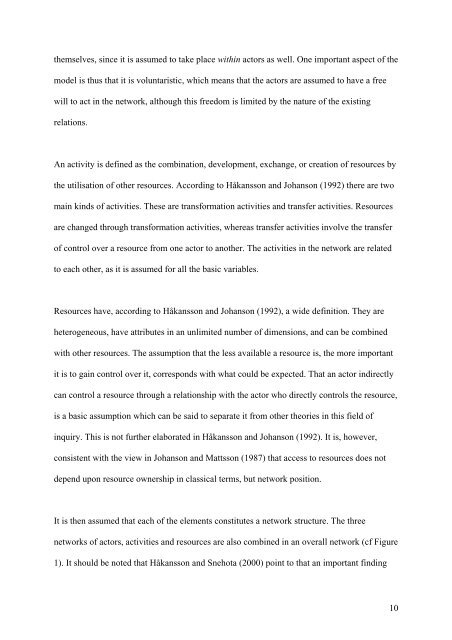Link to thesis. - Concept - NTNU
Link to thesis. - Concept - NTNU
Link to thesis. - Concept - NTNU
- No tags were found...
You also want an ePaper? Increase the reach of your titles
YUMPU automatically turns print PDFs into web optimized ePapers that Google loves.
themselves, since it is assumed <strong>to</strong> take place within ac<strong>to</strong>rs as well. One important aspect of themodel is thus that it is voluntaristic, which means that the ac<strong>to</strong>rs are assumed <strong>to</strong> have a freewill <strong>to</strong> act in the network, although this freedom is limited by the nature of the existingrelations.An activity is defined as the combination, development, exchange, or creation of resources bythe utilisation of other resources. According <strong>to</strong> Håkansson and Johanson (1992) there are twomain kinds of activities. These are transformation activities and transfer activities. Resourcesare changed through transformation activities, whereas transfer activities involve the transferof control over a resource from one ac<strong>to</strong>r <strong>to</strong> another. The activities in the network are related<strong>to</strong> each other, as it is assumed for all the basic variables.Resources have, according <strong>to</strong> Håkansson and Johanson (1992), a wide definition. They areheterogeneous, have attributes in an unlimited number of dimensions, and can be combinedwith other resources. The assumption that the less available a resource is, the more importantit is <strong>to</strong> gain control over it, corresponds with what could be expected. That an ac<strong>to</strong>r indirectlycan control a resource through a relationship with the ac<strong>to</strong>r who directly controls the resource,is a basic assumption which can be said <strong>to</strong> separate it from other theories in this field ofinquiry. This is not further elaborated in Håkansson and Johanson (1992). It is, however,consistent with the view in Johanson and Mattsson (1987) that access <strong>to</strong> resources does notdepend upon resource ownership in classical terms, but network position.It is then assumed that each of the elements constitutes a network structure. The threenetworks of ac<strong>to</strong>rs, activities and resources are also combined in an overall network (cf Figure1). It should be noted that Håkansson and Snehota (2000) point <strong>to</strong> that an important finding10
















